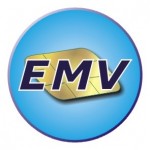EMV
What is EMV®?
EMV® stands for Europay, MasterCard and Visa, a global standard for Smart Cards or “Chip Cards”. These cards are replacing the “swipe” cards that exist today in the US. They will be used at credit card terminals, point of sale (POS) terminals and automated teller machines (ATMs), for processing credit and debit card transactions.
It is a joint effort initially conceived between Europay, MasterCard and Visa to ensure the security and global acceptance of smart cards. Europay International SA was absorbed into MasterCard in 2002. The standard is now defined and managed by the public corporation EMVCo LLC. JCB (formerly Japan Credit Bureau) joined the organization in December 2004, and American Express joined in February 2009. In May 2013 China UnionPay was announced as its latest member with UnionPay now having an equal 1/5 interest in the standards body along with Visa, MasterCard, American Express and JCB. Snart Card systems based on the EMV® specification are being phased in across the world, under names such as “IC Credit” and “Chip and PIN”.
The most widely known chip card implementations of EMV® standard are:
VSDC – Visa
M/Chip – MasterCard
AEIPS – American Express
J Smart – JCB
D-PAS – Discover/Diners Club International.
Visa and MasterCard have also developed standards for using EMV® cards in devices to support card-not-present transactions over the telephone and Internet. MasterCard has the Chip Authentication Program (CAP) for secure e-commerce. Its implementation is known as EMV-CAP and supports a number of modes. Visa has the Dynamic Password Authentication (DPA) scheme, which is their implementation of CAP using different default values.
Why Use EMV®?
What are the advantages to utilizing this standard?
- The greatest benefit of EMV® smart card chip and PIN card is the considerably stronger security against fraud. It is considerably more difficult to counterfeit a smart card compared to a conventional swipe card. Your standard swipe card is relatively easy to duplicate whereas a smart card has a chip in it that is more expensive and sophisticated technology.
- EMV® provides for greater cardholder verification methods as they can require a PIN and the store considerably more information than magnetic stripe card.
- EMV® payment cards, unlike magnetic swipe cards, can also be used to perform secure online payment transactions.
- Unlike the current swipe processing system in the US, EMV® also allows for greater world-wide international acceptance. In other words, consumers with EMV® chip payment cards can use their card on any EMV® terminal anywhere they are accepted in the world.
- EMV® also supports greater cardholder verification methods. EMV® payment cards, unlike magnetic stripe cards, can also be used to perform secure online payment transactions.
- More secure against credit card fraud than cards that rely only on data encoded in a magnetic stripe on the back of the card.
In short, EMV® is the new Gold Standard in credit card security and fraud protection.
EMV® is here and What it means to You.
All major US credit card brands are adopting EMV® and although it is not yet a requirement for merchants it soon will be. What this means is that all credit card transactions will be executed on an EMV® terminal. If you do not have an EMV®ready terminal, POS, ATM etc. then you will not be able to accept credit or debit cards. We have not been as yet given a solid date as to when this will happen, but it will and you should be ready.
You should purchase an EMV® Terminal – because it is now a full requirementAdditionally, with EMV® your risk of fraud is greatly reduced. At some point all of the EMV® chip card transactions improve security against fraud and reduces your risk of loss compared to magnetic stripe card transactions that rely on the holder’s signature and visual inspection of the card to check for features such as hologram.
The use of a PIN and cryptographic algorithms such as DES, Triple-DES, RSA and SHA provide authentication of the card to the processing terminal and the card issuer’s host system. The processing time is comparable to online transactions, in which communications delay accounts for the majority of the time, while cryptographic operations take comparatively little time. The supposed increased protection from fraud has allowed banks and credit card issuers to push through a ‘liability shift’ such that merchants are now liable (as from 1 January 2005 in the EU region) for any fraud that results from transactions on systems that are not EMV® capable.




